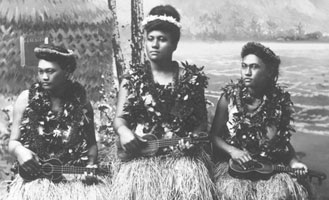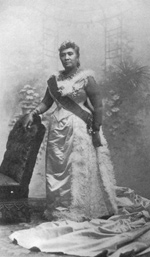History of the Ukulele
The Origins

Photo of three Hawaiian woman with ukuleles taken in the 1890s. Photo retrieved from Hawaiian State Archives.
While the ukulele is a uniquely Hawaiian instrument, its roots are in the Portuguese braguinha or machete de braga. The braguinha is a stringed instrument smaller than a guitar whose tuning is very similar to the first four strings of a guitar. By 1850, sugar plantations had become a major economic force in Hawaii, and the plantations needed more workers. Many waves of immigrants came to the islands, including a large number of Portuguese who brought their branguinhas with them.
Legend dates the beginning of the Hawaii infatuation with the branguinha to August 23, 1879. A ship called the Ravenscrag arrived in Honolulu Harbor and released its passengers after a rather arduous journey. One of the passengers began singing songs of thanksgiving for finally reaching his destination and accompanied himself with a branguina. The story goes that the local Hawaiians were very moved by his performance and nicknamed the instrument "Jumping Flea" (one possible translation of ukulele) for the way his fingers moved on the fretboard.
Evolution
While it is a fun story, the origin of the "jumping flea" name is impossible to prove; Queen Lili'uokalani, a great proponent of the ukulele, preferred the translation "gift that came here." What isn't in doubt is that the Ravenscrag also brought three Portuguese craftsmen: Augusto Dias, Manuel Nunes, and José do Espirito Santo, who each began to make instruments once they had paid for their passage working the sugar fields. In their hands the branguina transformed in size and shape and developed reentrant tuning which gives the ukulele its unique sound and easy playability.
Popularity

Photo of Queen Lili'uokalani, published in her autobiography, Hawaii's Story by Hawaii's Queen, in 1898. Photo retrieved from Wikipedia.
The popularity of the ukulele was assured by the patronage of the royal family. The Hawaiian king, King David Kalakauna, loved the ukulele so much he incorporated it into traditional Hawaiian dances and music. He and his sister, Lili'uokalani (who would become queen after him), would have songwriting contests on the ukulele. The monarchs of Hawaii made sure that the ukulele would become completely intertwined with the musical culture of Hawaii.
Spreading to the Mainland
In the early 1900s tourism in Hawaii was starting to take off, and people were enchanted by the beautiful tropical islands with their unique music and dance traditions. Several touring shows of Hawaiian performers crossed the mainland, introducing people to the sound of the ukulele. In 1915, the Panama-Pacific International Exposition was held in San Francisco to celebrate the completion of the Panama Canal. One of the exhibit areas was a Hawaiian Pavilion which featured daily performances by hula dancers and musicians. It proved to be one of the most popular exhibits at the Exposition. Tin Pan Alley songwriters fell in love with Hawaii and the ukulele became a popular instrument on the mainland, so much so that ukuleles started being made off the island.
The Present
The ukulele's popularity on the mainland waned after the 1950s with the beginnings of rock and roll. Where before every child wanted a ukulele, now they wanted a guitar. But the ukulele's easy playability and unique sound is helping it make a comeback in the present, with ukulele songs by Jason Mraz and Train making it onto the top 40 radio stations.
Of course, the ukulele never lost popularity in Hawaii. One of the most famous ukulele musicians is the late Israel "Iz" Ka'ano'i Kamakawiwo'ole (affectionatley known as Bruddah Iz by Hawaiians) whose cover of Somewhere Over the Rainbow/Wonderful World was an international bestseller. Another name to know is Jake Shimabukuro, who is considered by many to be a virtuoso on the ukulele. Jake is also notable for reaching worldwide attention from a single viral video on Youtube.
References
Beloff, J. (1997). The ukulele: a visual history. San Francisco: Miller Freeman Books.
Israel Kamakawiwo'ole. (2013) Israel Kamakawiwo'ole. Wikipedia. Retrieved from http://en.wikipedia.org/wiki/Israel_Kamakawiwo%CA%BBole.
Jake Shimabukuro. (2013) Jake Shimabukuro. Wikipedia. Retrieved from http://en.wikipedia.org/wiki/Jake_Shimabukuro.
King, J., & Tranquada, J. (2003). A new history of the origins and development of the 'ukulele, 1838-1915. The Hawaiian Journal of History, 37. 1-32.









